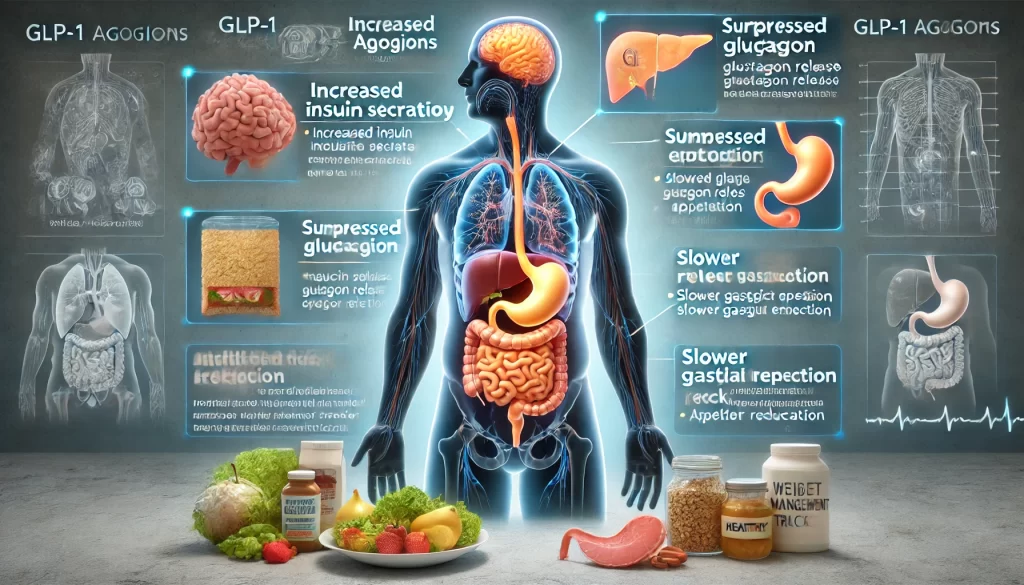Key Takeaways
- GLP-1 agonists, often referred to as semaglutide, work by increasing insulin sensitivity, decreasing hunger, and boosting satiety.
- GLP-1 agonists don’t work alone but must be complemented by appropriate diet and lifestyle changes.
- Semaglutide (Wegovy), liraglutide (Saxenda), and tirzepatide (Zepbound) are the only three FDA-approved GLP-1 agonist injectables approved for weight loss; there are other brands approved for type-2 diabetes
- GLP-1 agonists are associated with many potential adverse effects (especially gut-related), so the benefit/risk ratio must be carefully assessed before starting this drug.
- GLP-1s aren’t suitable for short-term weight loss as the lost weight can be regained once the drug is stopped.
- GLP-1 drugs can be quite expensive (more than $1,000/month), but they aren’t always covered by insurance. Check with your provider before making any decisions.
Type 2 diabetes is one of the most common and well-studied modern diseases. So, new medications to combat this condition are constantly being developed.
One such type of medication is called a glucagon-like peptide 1 (GLP-1) agonist. These meds have become increasingly popular recently because even though GLP-1 receptor agonists were initially developed to treat type 2 diabetes, they began to show a very promising benefit: significant weight loss.
If you think you’re a candidate for one of these medicines, read on to learn everything you need to know about GLP-1 agonists for weight loss, how they work, who should take them, their side effects, and more.
What Are GLP-1 Agonists?
Hormones are your body’s natural messengers. They carry important messages to different organs to keep your body functioning normally. Both insulin and GLP-1 peptide are naturally occurring hormones.
The food you eat gets broken down into simple sugars (like glucose) in your stomach.
This sugar then enters the bloodstream and travels throughout the body. Insulin directs the sugar from your blood into your cells to be used as energy.
But when insulin can’t do its job well anymore, the sugar remains in the blood, and you develop type 2 diabetes.
This is why people with diabetes have higher-than-normal blood sugar levels. It’s also why most diabetes medications (including GLP-1 agonists) are targeted towards blood sugar control.
But like all good planners, your body always has a backup. When insulin starts slacking off (like it does in folks with diabetes), your body sends out the GLP-1 hormone to pick up the slack.
When scientists discovered this smart move, they came up with a way to mimic the body’s actions. Thus, GLP-1 agonists were developed.
An agonist is any manufactured substance (like a drug or medication) that copies or boosts the actions of a naturally occurring substance (in this case, GLP-1) by stimulating its receptor.

How Does GLP-1 Work?
GLP-1 is usually produced in the small intestine. It has a four-fold messenger action:
- It tells the pancreas to increase insulin secretion to manage your blood sugar levels properly.
- It also tells the pancreas not to release hormones like glucagon, which can move glucose from other storage places (like the liver) into the bloodstream.
- It tells your stomach to digest the food slowly so that more sugars don’t get added to the bloodstream before insulin can clear them out.
- It tells your brain that you’re full and not hungry at all — aka, it decreases hunger and increases satiety. This prevents overeating and keeps you from taking in more food before the previous meal is fully digested.
This final action has caught the eye of the general public and has pushed GLP-1 agonists—the most well-known being semaglutide—into the limelight, even among people without diabetes.
GLP-1 agonists can decrease your appetite and keep you feeling full all the time. They may help you lose weight, especially if you find portion control challenging.
Does this mean anyone can take GLP-1 drugs to lose weight? Let’s explore the pros and cons of taking these medications for weight loss effects.
6 Key Considerations of GLP-1 Drugs
GLP-1 agonists were first approved for use as type 2 diabetes medication by the U.S. Food and Drug Administration (FDA) in 2005. These drugs are usually available in a liquid form, along with a needle and syringe.
You need to inject them into the fatty tissue under your skin. The most common injection site is the belly, followed by the outer thighs, upper buttocks, and the backs of your arms.
These drugs are usually recommended only after safer and more conventional methods like diet and exercise have failed to produce the desired results.
Even then, GLP-1 agonists aren’t miracle drugs and can’t work alone. They must be accompanied by dietary and lifestyle changes for long-term use.
1. Learn who can and cannot take these drugs
To benefit from GLP-1 agonist drugs, your body mass index should either be 30 or higher or be 27 or higher with a health complication like:
- Prediabetes or type 2 diabetes
- Cardiovascular disease
- High blood pressure
- High cholesterol
- Non-alcoholic fatty liver disease
- Obstructive sleep apnea
- Polycystic ovarian syndrome
According to MyFitnessPal’s registered dietician, Stephanie Nelson, you must consult your health care provider before starting this medication. This is because taking any medication comes with certain risks and possible side effects. A good health care provider will help you weigh the risks you face by taking the medication versus the risks of not taking it.
They’ll also factor in the health benefits you’ll receive by taking the medication. These drugs are best suited for individuals who are at health risk related to their weight. For example, if you have obesity, you’re at a higher risk of developing diabetes or heart disease.
But if you’re NOT at health risk, then these drugs aren’t recommended for you because they put you at unnecessary risk of side effects.
You also shouldn’t take GLP-1s if:
- You have a personal or family history of thyroid cancer, as they increase the risk of thyroid cancer.
- You’re pregnant, breastfeeding, or planning to get pregnant.
- You have severe bowel disease.
- You’re allergic/sensitive to semaglutide.
- You have a past or active eating disorder.
Another thing to consider when opting for GLP-1s is the influence of these drugs on your food consumption.
For example, GLP-1s impact food intake by quieting food noise and subconsciously getting you to choose less salty, sugary, and fatty foods. This speaks to how powerful your subconscious cues to eat are and the role your brain plays in obesity.
But this is a double-edged sword because you still need to be conscious and mindful of what you’re eating to ensure you’re eating enough—which is where tracking what you eat comes in.
While taking GLP-1 medications, you need to stay disciplined about making nutritious food choices and tracking your calories to prevent malnutrition and achieve healthy weight loss.

2. Know the GLP-1 drugs available and their effectiveness
Many GLP-1 medications are available on the U.S. market. However, only the following three are currently approved by the FDA for use as weight-loss drugs:
Semaglutide (Wegovy)
- Type: injectable
- Frequency: weekly
- Starting dose: 0.25 to 1.7 mg for the first 16 weeks
- Maintenance dose: 2.4 mg
- Efficacy findings:
- Manufacturer-sponsored studies of 803 and 1,961 people: average decrease in body weight of 7.9% and 14.9%, respectively, with smaller waists and lower total cholesterol levels, systolic blood pressure, and triglycerides
- Research review in 2021: weekly dose of Wegovy led to weight reduction effects in multiple studies
Liraglutide (Saxenda)
- Type: injectable
- Frequency: daily
- Starting dose: 0.6 mg/day (with weekly increases)
- Maintenance dose: 3 mg/day
- Eligibility: Obese adults and obese children older than 12 years
- Efficacy findings:
- 2021 study of 169 people with obesity: 62.1% lost at least 5% of their body weight over 6 months and 17.2% lost at least 10% of their body weight
- 2021 manufacturer-sponsored study of 277 people: 9-lb weight loss over 7 months
- 2022 study comparing Wegovy and Saxenda in 338 people: Wegovy caused more weight after 68 weeks due to decreased hunger and food cravings
Tirzepatide (Zepbound)
- Dual GLP-1/glucose-dependent insulinotropic polypeptide (GIP) receptor agonist
- Type: injectable
- Frequency: weekly
- Starting dose: 2.5 mg in 0.5-mL liquid solution for the first 4 weeks
- Maintenance dose: 5, 7.5, 10, 12.5, or 15 mg from week 5 (based on treatment response and drug tolerance)
- Efficacy findings:
- Manufactured-sponsored SURMOUNT-3 trial: total mean weight loss of 26.6% over 84 weeks
- Manufactured-sponsored SURMOUNT-4 trial: total mean weight loss of 26% over 88 weeks
3. Keep in mind their potential side effects
GLP-1 agonists come with a long list of potential adverse effects such as:
- Digestive system: stomach pain, nausea, vomiting, constipation, diarrhea, heartburn, indigestion, flatulence, bloating, belching, and gastroesophageal reflux
- Nervous system: headache, dizziness, fatigue, mood changes, and suicidal behavior or ideation
- Low blood sugar and diabetic retinopathy in people with diabetes
- Allergic reactions
- Drug interactions
- Heart rate changes
- Gall stones
- Pancreatitis
- Kidney damage
- Increased risk of thyroid cancer
According to cardiologist and MyFitnessPal scientific advisor Danielle Belardo, MD, most gut-related side effects can be resolved through dietary changes like eating smaller meals, increasing fiber intake, and staying hydrated.
4. Understand the insurance coverage of these drugs
Insurance coverage for GLP-1 agonists like semaglutide depends on several factors, such as the type of medication, plan, provider, and health condition.
GLP-1s are sometimes covered by insurance, but only if deemed medically necessary. For example, some providers cover them if they’re used to treat type 2 diabetes.
Medicare doesn’t cover these drugs for weight loss, but in some states, Medicaid does.
Be sure to check with your provider before starting this drug. Some plans may require prior authorization or a documented diagnosis. You may also need to meet certain health criteria or pay some copayment amount.
Wegovy and Saxenda cost $1,349.02 per monthly package.
Zepbound costs around $1,059.87 per month.
Novo Nordisk and Eli Lilly (the manufacturers) offer savings programs for people without insurance coverage.
With this, you can save around $500 a month for a four-week supply of Wegovy or Zepbound. According to the company, most people with commercial coverage for this drug pay less than $25 per month.
5. Know the obesity treatment alternatives to GLP-1
Here are some strategies for weight management if GLP-1s aren’t for you:
- Opt for home-cooked instead of ultra-processed foods.
- Make small, sustainable changes to nutrition.
- Add more protein and fiber to your diet.
- Cut down on high-sugar beverages. Drink more plain water instead.
- Make sure to get adequate, high-quality sleep.
- Move your body more — whether it’s through exercise, taking a walk, or even doing chores.
- In extreme cases, consider other weight loss treatments like surgery or medications that cause weight loss (like phentermine).
- Seek advice from professionals like a registered dietician, psychologist, endocrinologist, or physical therapist to receive customized care tailored to your needs.
6. Keep in mind the maximum treatment duration for GLP-1
Research shows that people gain around two-thirds of their lost weight back within a year after stopping GLP-1 supplements. So, these drugs may not be your best choice for long-term weight loss.
Obesity is considered a chronic condition. Drugs like GLP-1s suppress cravings, increase insulin sensitivity, and mute obesity-promoting pathways in the body. But these effects can be reversed once the drug is stopped.
In short, GLP-1s can be used for the treatment of obesity but cannot cure it completely. That’s why you need to be mentally prepared to be on GLP-1s potentially for life if you wish to receive permanent benefits.
The Bottom Line: GLP-1s Aren’t Right for Everyone
Choosing the right drug is dependent on many factors like your health status, drug tolerance, budget, and insurance coverage. Speak to your health care provider before starting any medications.
At the end of the day, diet and exercise are just as important in a successful weight loss journey. For an easy start, introduce small changes like planning your meals, tracking your calories, or creating an exercise routine.







